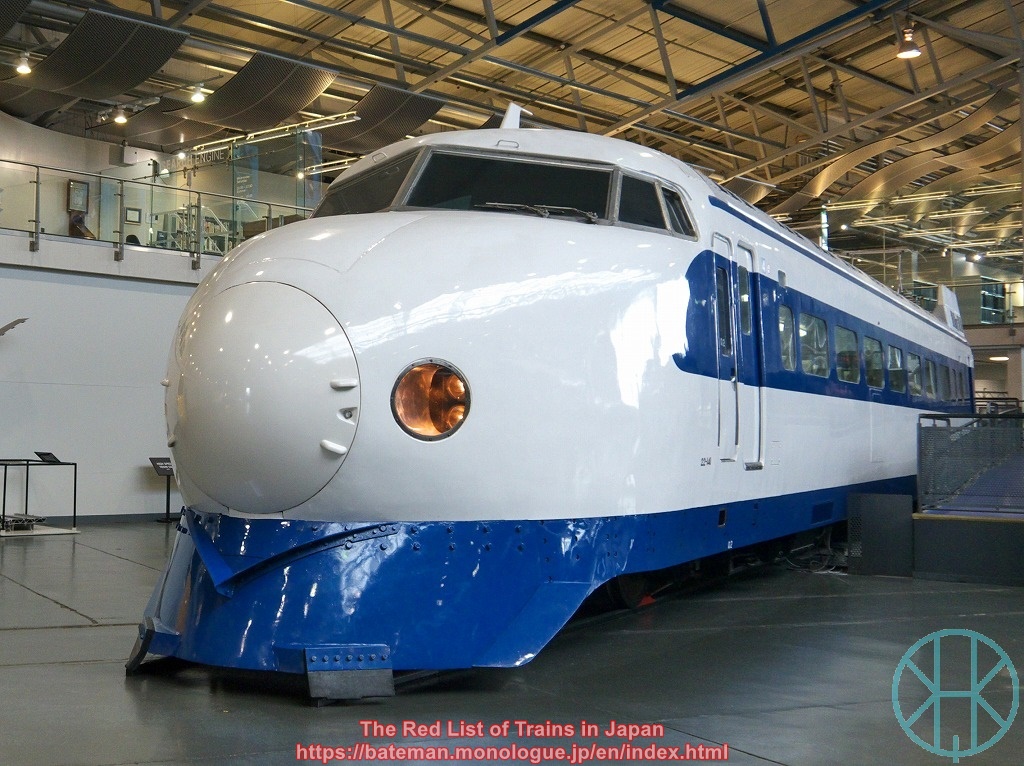0 series Bullet Train

Data (as of 12 Aug 2022)
| Status: | Extinct |
| Constructed in: | 1964-86 |
| Number built: | 3,216 |
| Retired in: | 2008 |
History
The 0 series is definitely the most famous train in Japan, as it was the very first high-speed train in the world. Since it was the only bullet train for passenger service in the country until 200 series was developed, the 0 series had been simply called "the bullet train" (新幹線電車). It was sometimes called 000 series as well until the early-1980s.
The 0 series appeared to be an epoch-making train, but it was based on existing technologies as engineers pursued reliability. Their traction, motors and brakes were based on those of other conventional trains, the front end was modelled after aeroplanes at that time. The maximum speed of over 200 km/h was not something new in the world, as a steam locomotive Mallard reached the world record of 203 km/h (126 mph) in 1938 as did other experimental trains in Germany. Even so, the 0 series was ground-breaking as all of these features constituted a new railway system as a whole called Tokaido Shinkansen.
3,216 carriages were built in nearly 23 years, becoming the most numerous bullet train in the history, though not all of them existed at the same time (at its peak, 2,338 carriages were registered in 1976). However, it was not necessarily an honourable record: Japanese National Railways had no other choice but introducing the 0 series with no innovation for over twenty years due to disputes over new rolling stock with trade unions and frequent industrial action. It was one of the reasons why Japanese Shinkansen was surpassed by French TGV in the 1970s and 80s.
The 0 series was initially formed of 12 coaches including Green Cars (first class) and dining or buffet cars, but later became 16 coaches due to a sharp increase in demand. The maximum speed was set to 210 km/h (130 mph) at first, but raised to 220 km/h (137 mph) in 1986. They were used for Hikari and Kodama services on both Tokaido and Sanyo Shinkansen. When JNR was privatised in 1987, 768 carriages were allocated to JR Central and 358 carriages to JR West. Both companies suffered from their low maximum speed.
JR Central introduced 100 series and 300 series to replace the 0 series. It was mostly used for Kodama stopping services, but there were a few Hikari semi-fast services during peak seasons. JR Central withdrew all of them by 1999.
JR West used the 0 series longer than JR Central. Some of them were dramatically refurbished and allocated to West Hikari (Shin-Osaka - Hakata, semi-fast), while others were shortened to four or six coaches and used for Kodama services. Some carriages had a playroom for infants. Many of them were withdrawn by the early-2000s, but a few of them remained and repainted grey with light green bands. They were restored to the original livery in 2008, months before retirement.
The 0 series retired in 2008 after being in service for more than 40 years. Farewell tours were held with thousands of enthusiasts and local residents, sending off the symbol of the railway in Japan.
Fun Facts
On 1 October 1964, the very first service of Tokaido Shinkansen ran from Shin-Osaka to Tokyo. There was a plenty of time allowance as JNR feared that a technical trouble might occur. The driver was ordered to keep the train running at 160 km/h (100 mph), but passengers were so eager to enjoy a high-speed journey that he raised the speed to 210 km/h (130 mph). As a result, the next driver had to slow down significantly as the train was about to arrive at Tokyo too early.
There was no window between a restaurant and a corridor on a dining car, but many passengers dissatisfied with the restaurant where they could not see Mt. Fuji, and asked JNR to do something. In 1979, JNR installed windows in response to those requests.
There was a trainset designated for imperial train. It had a white V letter below a coupler, and later blue bands were added near headlights. However, these features were erased as the train could be targeted by terrorists.
There are over 20 carriages in static display, and two of them are preserved outside Japan: Tainan city in Taiwan and York in the United Kingdom.
